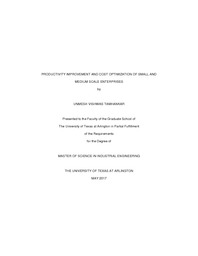
ATTENTION: The works hosted here are being migrated to a new repository that will consolidate resources, improve discoverability, and better show UTA's research impact on the global community. We will update authors as the migration progresses. Please see MavMatrix for more information.
Show simple item record
| dc.contributor.advisor | LeBoulluec, Aera Kim | |
| dc.creator | Tamhankar, Unmesh Vishwas | |
| dc.date.accessioned | 2017-07-03T15:12:42Z | |
| dc.date.available | 2017-07-03T15:12:42Z | |
| dc.date.created | 2017-05 | |
| dc.date.issued | 2017-05-11 | |
| dc.date.submitted | May 2017 | |
| dc.identifier.uri | http://hdl.handle.net/10106/26805 | |
| dc.description.abstract | Productivity improvement and cost optimization have been a topic of discussion for at least a century. The publication of Fredrick Taylor’s book ‘The Principles of Scientific Management’ in 1911 can be considered as the beginning of the Efficiency movement. Surprisingly, the awareness about the principles of Industrial Engineering is relatively low in many family-owned Small and Medium Scale Enterprises (SMEs). According to a World Bank report, formal SMEs make up 45% of total employment and contribute 33% of GDP in emerging markets. In the USA, SMEs make up for more than 95% of all firms and employ 50% of private sector employees. Therefore, it is self-evident that improvement in the productivity of this sector will have a sizable impact on the economy. Productivity increase and cost optimization are critical tasks for SMEs. In a competitive environment, increasing productivity without installing additional capacity enables the SMEs to avoid heavy investment and maximize their profitability. In comparison with large-scale industries, the SMEs have less cash to spend, and skilled professionals who can implement productivity improvement strategies such as Lean, Six Sigma, Total Quality Management, etc. are not readily available most of the time. Thus, productivity improvement can become a costly and difficult exercise. Therefore, there is a need of a fast and cost effective solution to the problem of productivity improvement. This work offers a time saving productivity improvement and cost optimization solution for an SME through the implementation of lean methodology and the use of modern simulation packages (Simio). The implementation of lean methodologies supports elimination of waste and makes available resources that were incorrectly allocated, resulting in an increment in productivity. The simulation packages serve as a visual aid to understand the interrelation between various components of the enterprise. Additionally, they serve as a tool for the what-if analysis in case of any changes being made in the existing setup. Most importantly, the use of simulation eliminates the necessity of multiple trial and error cycles, which in turn saves time and reduces the overall cost of the improvement effort undertaken by the company. Finally, this research aims to establish this method of implementation of productivity improvement solution as a standard for similar SMEs to achieve quick results with minimum cost incurred. | |
| dc.format.mimetype | application/pdf | |
| dc.language.iso | en_US | |
| dc.subject | Productivity improvement | |
| dc.subject | Simulation | |
| dc.subject | Lean manufacturing | |
| dc.subject | Cost optimization | |
| dc.subject | Industrial engineering | |
| dc.title | Productivity Improvement and Cost Optimization of Small and Medium Scale Enterprises | |
| dc.type | Thesis | |
| dc.degree.department | Industrial and Manufacturing Systems Engineering | |
| dc.degree.name | Master of Science in Industrial Engineering | |
| dc.date.updated | 2017-07-03T15:13:45Z | |
| thesis.degree.department | Industrial and Manufacturing Systems Engineering | |
| thesis.degree.grantor | The University of Texas at Arlington | |
| thesis.degree.level | Masters | |
| thesis.degree.name | Master of Science in Industrial Engineering | |
| dc.type.material | text | |
Files in this item
- Name:
- TAMHANKAR-THESIS-2017.pdf
- Size:
- 2.137Mb
- Format:
- PDF
This item appears in the following Collection(s)
Show simple item record


